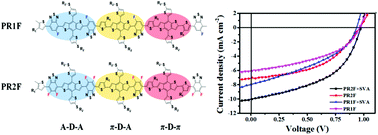Regio-asymmetric polymers based on fluorinated benzothiadiazole–benzodithiophene for polymer solar cells with a high open-circuit voltage
Abstract
Two regio-asymmetric polymers PR2F and PR1F with three repeat units A–D–A, π–D–A, and π–D–π along the polymer backbone were obtained by polymerizing different fluorinated benzothiadiazole–thiophene units, FBT-T and 2FBT-T units (A–π), with a benzodithiophene unit (D), respectively. Here, the new regio-asymmetric polymers were different from traditional polymers featuring a D–A or D–π–A–π backbone. Both the regio-asymmetric polymers showed a low lying HOMO energy level in relation to that of the PC61BM acceptor and then a high open-circuit voltage of ∼1 V was observed in both PR2F and PR1F devices. Bulk-heterojunction devices based on PR2F with difluorinated BT exhibited an appreciable power conversion efficiency (PCE) of 4.73% due to the relatively high and balanced charge carrier mobilities, while the mono-fluorinated BT polymer PR1F-based devices showed a lower PCE of 2.92%. These results indicate that the regio-asymmetric conjugated polymers are a promising class of materials for polymer solar cell applications, and it is significant to further understand the influence of the polymer structure on the optoelectronic properties.



 Please wait while we load your content...
Please wait while we load your content...